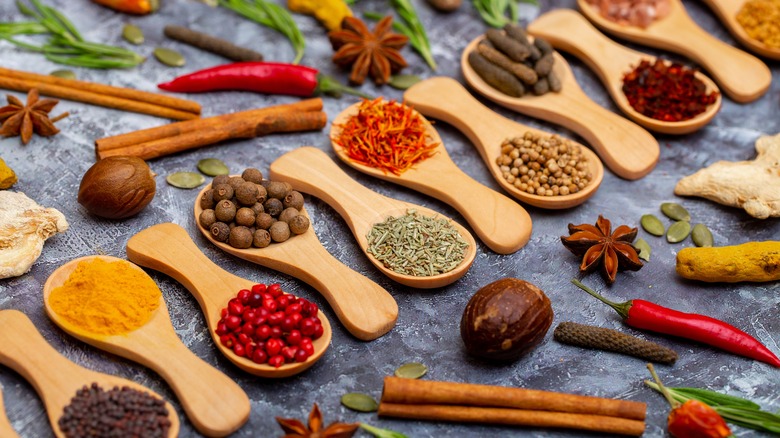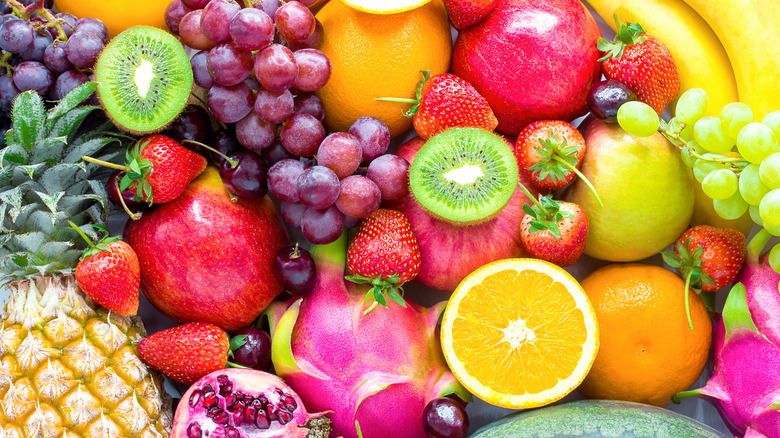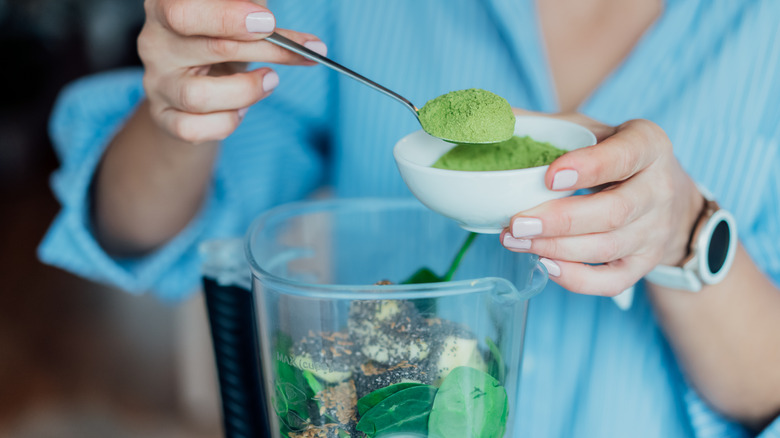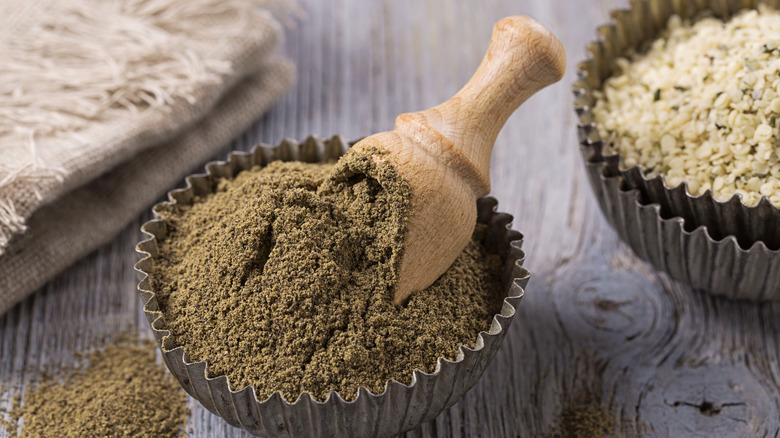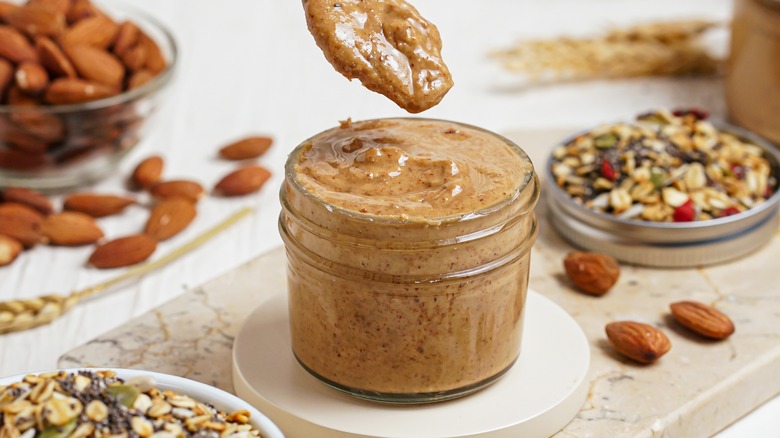The 6 Biggest Mistakes You're Making With Your Smoothies
We're a little biased, but frankly, smoothies are easily one of the best breakfasts out there. And look, if you're a smoothies-for-lunch kind of person, who are we to judge? There are a ton of reasons why smoothies might be your go-to. They're portable and easy to consume on the go whether you're commuting to work or enjoying the early morning vibes on a morning stroll. They're also relatively low-effort when compared to other breakfasts; even though they can contain a fair number of ingredients the process never gets more complicated than "throw in a blender and push a button." Smoothies are also wildly customizable, which is great news for anyone that likes to drink the same specific thing every morning or the folks who like to change things up every day of the week.
Food has no moral value; there's no "good" or "bad" way to make a smoothie. But there are some things you can do to ensure that your smoothie is serving your body (and your taste buds) as best it can. Below you'll find some recommendations for how to do just that, from ingredients folks tend to ignore to suggestions on what to do to make sure your breakfast keeps you energized and satiated.
1. Not adding dry spices
You know what they say: Variety is the spice of life. And if you're not spicing up your smoothies, as it were, you're missing out. Not only can your spice cabinet add a punch of flavor to the drabbest of mornings, but many spices also contain marked health benefits. And given that most ground spices are shelf-stable for 2 to 4 years, an initial investment in a dedicated smoothie spice is totally worth it. Adding spices to your smoothies is an easy, delicious, and healthy way to level up your smoothie game and make breakfast feel more decadent.
Speaking of which, cinnamon is packed with antioxidants and may have anti-inflammatory properties, according to Pharmacognosy Research. There are also studies that suggest that cinnamon can reduce risk factors for heart disease and lower blood pressure. While plenty of recipes go the liquid cinnamon roll route, others are more fruit-forward.
Another spice to consider adding to your smoothie routine is turmeric. In addition to its vibrant, golden color pop and earthy flavor, turmeric's main active ingredient, curcumin, is known to have a slew of health benefits. Curcumin is a natural anti-inflammatory compound that may lower your risk of heart disease, and may even prevent cancer, per a review in Molecules. Intrigued? Consider checking out this mango smoothie with turmeric, green tea, and ginger. One final dried spice to consider adding to your smoothies is cardamom, a powerful aromatic that may lower blood pressure, fight cancer, and aid digestion.
2. Overdoing it on the sugar
If any of your smoothie goals are health-related, you're going to want to be mindful of the sugar content. Truly, at the end of the day, the difference between a "healthy" smoothie and an "unhealthy" one is the amount of added sugar. Sugar is responsible for a whole host of advisory health effects, from heart disease to acne development. Using a light touch with sweeteners like honey, maple syrup, or agave might already be on your radar. But there are plenty of other go-to smoothie ingredients that can contain more sugar than you'd expect — coconut water, nut butters, and some flavored milk alternatives contain added sugar.
Dieticians recommend sticking to using fruit to sweeten your smoothies naturally, per Popsugar. However, it's important to remember that some fruits contain way more sugar than others. Three ounces of mangoes and bananas contain over 10 grams each (which is a decent chunk of your daily recommended sugar intake). But fear not! There are plenty of low-sugar fruits that are great smoothie mainstays, including raspberries (at 3.7 grams per .3 ounces), strawberries (at 4.1 grams per 3 ounces), and blackberries (at 4.2 grams per 3 ounces).
3. Ignoring leafy greens
Look, we get it: The idea of starting your day with a salad isn't exactly an easy sell. But in practice, incorporating leafy greens into your regular breakfast smoothie routine is both a delicious and easy way to step up your nutrition game. According to a 2015 study by the CDC, only 9% of American adults are eating the daily recommended serving of fruits and vegetables. And while adding fruit to smoothies is a bit of a no-brainer, if you're skimping on the veg — especially fiber-rich leafy veg — you're missing out on an opportunity to make your smoothie (and your health) the best it can be.
Without adding too many extra calories of sugar, leafy greens like spinach, kale, and even swiss chard are great additions to any smoothie. If you're wondering about where to start, spinach is a go-to with a swath of health benefits, from cancer prevention to essential vitamins like K and C. To boot, a 2019 study from Linköping University suggests that drinking spinach in combination with fat (like peanut butter or yogurt, two smoothie staples) increases the bioavailability of the antioxidant lutein, which is in charge of reducing inflammation.
Simply toss a handful (or a frozen cube) of spinach in with any smoothie like you would any supplement. If your smoothies err on the lighter side, this may affect the color — but if that's not a dealbreaker for you, then knock yourself out (with spinach!).
4. Adding too much or too little protein
While the phrase "protein smoothie" might conjure visions of muscle-bound weightlifters, making sure that your liquid breakfast is packed with protein isn't just for gym rats! As the American Society for Nutrition describes, packing your breakfast with protein is a surefire way to start your day off on the right foot. Beginning your day with a high-protein breakfast helps to keep your blood sugar levels stable and can curb energy crashes. Plus, as Runner's World adds, consuming around 30 grams of protein for breakfast will help you stay satisfied for longer.
There are plenty of plant-based proteins that pack a punch that would make welcome additions to any smoothie if you want to avoid powders, including oats and seeds. That said, if you're down with incorporating powders — which are often the easiest way to add substantial protein to a smoothie — there are lots of options out there (including whey protein if you're able to ingest dairy and pea protein if you prefer to stay plant-based).
But with that convenience, it's important to make sure that you're adding the correct amount of protein for your body's individual needs. Per the Mayo Clinic, the general recommendation is to consume somewhere in the area of 15 to 30 grams per meal. Not getting enough protein means that you will miss out on the boost that comes with a protein-packed breakfast, and too much protein will have no added benefit.
5. Skimping on fiber
Dietary fiber is one of those nutrition buzzwords that gets thrown around a lot, but not always with an explanation of what it does, exactly. So before we go any further, let's do a super brief rundown of what fiber is and why you should make an effort to integrate fibrous foods into your smoothie recipes.
Dietary fiber refers to non-digestible vegetable carbs. As Harvard T.H. Chan School of Public Health describes, there are two primary variations of dietary fiber: soluble fiber (which, as its name describes, dissolves in liquids) and insoluble fiber (which does not dissolve in water). Foods rich in soluble fiber include oatmeal, chia seeds, nuts, and blueberries, all of which would make a welcome addition to any smoothie. Soluble fiber-rich foods can lower glucose levels and blood cholesterol and are beneficial for heart health (via the Mayo Clinic).
Meanwhile, the boons of ingesting insoluble fiber-rich foods are focused on regulating digestion, particularly bowel health, per Healthline. Examples of smoothie-friendly, insoluble fiber-rich foods include leafy greens (like kale, spinach, and swiss chard), almonds, walnuts, seeds, a fruit peels.
In truth, the best way to get your bowels in the happiest shape is a combination of soluble and insoluble fiber. But considering that many of the above foods are shelf-stable, tossing in a tablespoon of chia seeds and a couple of walnuts is a small price to pay for good bowel movements.
6. Shying away from healthy fats
Not all fats are created equal. While some fats — like the trans fats, which are found in fried foods — can increase the risk of heart attacks and heightened cholesterol levels, others serve a necessary dietary purpose. Our bodies need healthy fats to create energy and make us feel satiated, per the American Heart Associated. So, in order for a smoothie to do its job as a whole entire meal, you need to ensure that it's more than just liquid sugar. Make sure that you're not falling into the trap of many "fat-free" foods, which overcompensate by doubling down on added sucrose.
There are plenty of wonderful and healthy, monounsaturated fats you can add to your smoothies. If you want a creamy profile, consider adding some slices of avocado, which is a great source of potassium and fiber (via Medical News Today). Other monosaturated fats to consider include nuts and nut butter, which are packed with magnesium and can lower your diabetes risk. Meanwhile, good sources of polyunsaturated fats that are easily added to smoothies include walnuts, ground flaxseeds, and chia seeds. If you find that you get hungry a couple of hours after your smoothie, consider experimenting with adding more healthy fats to your regular smoothie routine.

